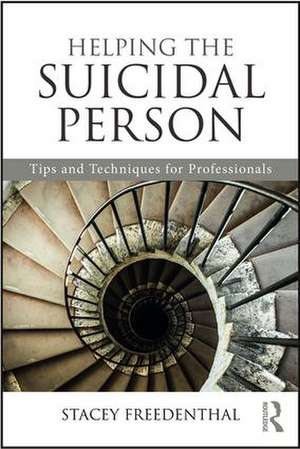Helping the Suicidal Person: Tips and Techniques for Professionals
Autor Stacey Freedenthalen Limba Engleză Paperback – 22 sep 2017
| Toate formatele și edițiile | Preț | Express |
|---|---|---|
| Paperback (1) | 259.32 lei 3-5 săpt. | +18.91 lei 7-13 zile |
| Taylor & Francis – 22 sep 2017 | 259.32 lei 3-5 săpt. | +18.91 lei 7-13 zile |
| Hardback (1) | 1161.59 lei 6-8 săpt. | |
| Taylor & Francis – 19 sep 2017 | 1161.59 lei 6-8 săpt. |
Preț: 259.32 lei
Preț vechi: 272.97 lei
-5% Nou
Puncte Express: 389
Preț estimativ în valută:
49.62€ • 54.07$ • 41.81£
49.62€ • 54.07$ • 41.81£
Carte disponibilă
Livrare economică 02-16 aprilie
Livrare express 19-25 martie pentru 28.90 lei
Preluare comenzi: 021 569.72.76
Specificații
ISBN-13: 9781138946958
ISBN-10: 1138946958
Pagini: 288
Ilustrații: 2 Tables, black and white
Dimensiuni: 152 x 229 x 22 mm
Greutate: 0.38 kg
Ediția:1
Editura: Taylor & Francis
Colecția Routledge
Locul publicării:Oxford, United Kingdom
ISBN-10: 1138946958
Pagini: 288
Ilustrații: 2 Tables, black and white
Dimensiuni: 152 x 229 x 22 mm
Greutate: 0.38 kg
Ediția:1
Editura: Taylor & Francis
Colecția Routledge
Locul publicării:Oxford, United Kingdom
Public țintă
General, Professional, and Professional Practice & DevelopmentCuprins
I. Understanding Suicide and You Tip 1: Reflect on Your Biases about Suicide Tip 2: Take Stock of Your Experiences with Suicide (or Lack Thereof) Tip 3: Confront "Suicide Anxiety" Tip 4: Be Alert to Negative Feelings Toward the Suicidal Person Tip 5: Reject the Savior Role Tip 6: Maintain Hope II. Overcoming the Taboo Tip 7: Face Your Fears Tip 8: Directly Ask about Suicidal Thoughts Tip 9: Turn to Techniques for Eliciting Sensitive Information Tip 10: Embrace a Narrative Approach: "Suicidal Storytelling" Tip 11: Ask about Suicidal Imagery, Too Tip 12: Uncover Fears of Hospitalization and Other Obstacles to Disclosure III. Joining with the Suicidal Person Tip 13: Recognize that, for Some People, You are an Enemy Tip 14: Avoid Coercion and Control Whenever Possible Tip 15: Resist the Urge to Persuade or Offer Advice Tip 16: Understand the Person’s Reasons for Dying Tip 17: Validate the Wish to Die Tip 18: Acknowledge that Suicide is an Option IV. Assessing Danger Tip 19: Gather Remaining Essentials about Suicidal Thoughts and Behavior Tip 20: Learn About Prior Suicidal Crises: The CASE Approach Tip 21: Cautiously Use Standardized Questionnaires Tip 22: Privilege Warning Signs Over Risk Factors Tip 23: Screen for Access to Firearms Tip 24: Inquire about Internet Use Tip 25: Probe for Homicidal Ideation Tip 26: Collect Information from Family, Professionals, and Others V. Assessing Protective & Cultural Factors Tip 27: Examine Reasons for Living Tip 28: Identify Other Protective Factors Tip 29: Pay Attention to Culture Tip 30: Investigate Religious and Spiritual Views of Suicide VI. Putting It All Together: Estimating Risk Tip 31: Solicit the Person’s Own Assessment of Suicide Risk Tip 32: Estimate Acute Risk for Suicide Tip 33: Estimate Chronic Risk for Suicide Tip 34: Document Generously VII. Attending to Immediate Safety Tip 35: Know When and Why to Pursue Hospitalization Tip 36: Know When and Why Not to Pursue Hospitalization Tip 37: Do Not Use a No-Suicide Contract Tip 38: Collaboratively Develop a Safety Plan Tip 39: Encourage Delay Tip 40: Problem-Solve around Access to Firearms Tip 41: Discuss Access to Other Means for Suicide, Too Tip 42: In Case of Terminal Illness, Proceed Differently (Perhaps) Tip 43: Seek Consultation VIII. Planning for Treatment Tip 44: Make Suicidality the Focus Tip 45: As Needed, Increase Frequency of Contact Tip 46: Treat Chronic Suicidality Differently Tip 47: Involve Loved Ones Tip 48: Suggest a Physical Exam Tip 49: Recommend an Evaluation for Medication Tip 50: Continue to Monitor Suicidal Ideation IX. Alleviating Psychological Pain Tip 51: After Safety, Address Suffering Tip 52: Look for Unmet Needs Tip 53: Target Social Isolation Tip 54: Use Grounding Exercises X. Exploring Motivations and Misgivings Tip 55: Assume Nothing: Does the Person Want to Give Up Suicide? Tip 56: Tap Into Ambivalence Tip 57: Compare Reasons for Living and Dying Tip 58: Invite the Person to Look for the "Catch" Tip 59: Search for Exceptions XI. Inspiring Hope Tip 60: Frame Suicide as a Problem-Solving Behavior Tip 61: Help Brainstorm an "Options List" Tip 62: Teach the Problem-Solving Method Tip 63: Nourish Future Plans and Goals Tip 64: Incorporate a Hope Kit Tip 65: Highlight Strengths XII. Drawing from Cognitive Behavior Strategies Tip 66: Connect Suicidal Thoughts to Other Thinking Tip 67: Educate about Cognitive Distortions Tip 68: Help Challenge Negative Thoughts Tip 69: Elicit Coping Statements Tip 70: Rescript Suicidal Imagery Tip 71: Discourage Thought Suppression Tip 72: Foster Acceptance of Suicidal Thoughts XIII. Improving Quality of Life Tip 73: Enhance Coping Skills Tip 74: Cultivate Mindfulness Tip 75: "Broaden and Build" Positive Emotions Tip 76: Pair Behavioral Activation with Values XIV. Moving Forward After a Suicide Attempt Tip 77: Differentiate Between Suicidal and Non-Suicidal Self-Injury Tip 78: Determine the Person’s Reaction to Having Survived Tip 79: Conduct a Chain Analysis Tip 80: Evaluate Where the Safety Plan Fell Short Tip 81: Take Advantage of the "Teachable Moment" Tip 82: Attend to the Therapeutic Relationship Tip 83: Address the Trauma of the Suicide Attempt Tip 84: Explore Shame and Stigma XV. Building Resilience Tip 85: Warn about the Possibility of Relapse Tip 86: Review Lessons Learned Tip 87: Complete a Relapse Prevention Protocol Tip 88: Propose a Letter to the Suicidal Self Tip 89: Follow Up
Notă biografică
Stacey Freedenthal, PhD, LCSW, is an associate professor at the University of Denver Graduate School of Social Work. Her psychotherapy and consulting practice focuses on suicide assessment and intervention.
Recenzii
"This book is an extraordinary contribution to clinical suicide prevention—there is nothing like it. Dr. Freedenthal has created a treasure trove of ideas and techniques for any clinician who works with a suicidal person. Well informed by science, superb therapeutic wisdom, and clinical savvy, this readable and practical book is peppered with interesting case examples and suggestions for how to say difficult things. Providers need to keep this book close by to help ensure sound judgement and clinical competency when they care for those who struggle on the edge of life. By uniquely enhancing clinical care, this book is going to help save lives."
David A. Jobes, PhD, ABPP, professor of psychology and associate director of clinical training, Catholic University of America
"This book is essential reading for professionals working with suicidal individuals. It reflects the latest in suicide prevention research and theory and represents the cutting edge of therapeutic intervention, but it is organized for the clinician. Helping the Suicidal Person will be my recommended text for all my trainings and I would strongly recommend it for any training program, community agency, or private practice clinician who wants to be more effective and more confident helping suicidal individuals survive and thrive."
Kate Comtois, PhD, MPH, professor, Department of Psychiatry and Behavioral Sciences, University of Washington
"This jewel of a book belongs on the shelf of every mental health clinician who is weary of books that never quite get around to ‘what to do’ for suicidal individuals. Dr. Freedenthal has assembled an invaluable set of guidelines that are expressed with compassion and in plain English, yet richly informed by scientific research on why people become suicidal and how best to help them. This book fills an important void in the clinical literature; it is a splendid resource for the serious clinician, whether beginner or veteran."
Thomas E. Ellis, PsyD, ABPP, professor of psychiatry and behavioral sciences, Baylor College of Medicine, and senior psychologist, The Menninger Clinic
"An excellent book for both the novice looking to learn how to best assess and treat suicide risk and the experienced clinician wanting quick, research-based tips to enhance their work with suicidal people. This book condenses all the latest suicide theory and research alongside vignettes into brief chapters that can be easily accessed by the busy clinician."
Julie Cerel, PhD, licensed psychologist and professor, University of Kentucky College of Social Work, and president of the American Association for Suicidology
David A. Jobes, PhD, ABPP, professor of psychology and associate director of clinical training, Catholic University of America
"This book is essential reading for professionals working with suicidal individuals. It reflects the latest in suicide prevention research and theory and represents the cutting edge of therapeutic intervention, but it is organized for the clinician. Helping the Suicidal Person will be my recommended text for all my trainings and I would strongly recommend it for any training program, community agency, or private practice clinician who wants to be more effective and more confident helping suicidal individuals survive and thrive."
Kate Comtois, PhD, MPH, professor, Department of Psychiatry and Behavioral Sciences, University of Washington
"This jewel of a book belongs on the shelf of every mental health clinician who is weary of books that never quite get around to ‘what to do’ for suicidal individuals. Dr. Freedenthal has assembled an invaluable set of guidelines that are expressed with compassion and in plain English, yet richly informed by scientific research on why people become suicidal and how best to help them. This book fills an important void in the clinical literature; it is a splendid resource for the serious clinician, whether beginner or veteran."
Thomas E. Ellis, PsyD, ABPP, professor of psychiatry and behavioral sciences, Baylor College of Medicine, and senior psychologist, The Menninger Clinic
"An excellent book for both the novice looking to learn how to best assess and treat suicide risk and the experienced clinician wanting quick, research-based tips to enhance their work with suicidal people. This book condenses all the latest suicide theory and research alongside vignettes into brief chapters that can be easily accessed by the busy clinician."
Julie Cerel, PhD, licensed psychologist and professor, University of Kentucky College of Social Work, and president of the American Association for Suicidology
Descriere
Helping the Suicidal Person provides a highly practical toolbox for mental health professionals.



























